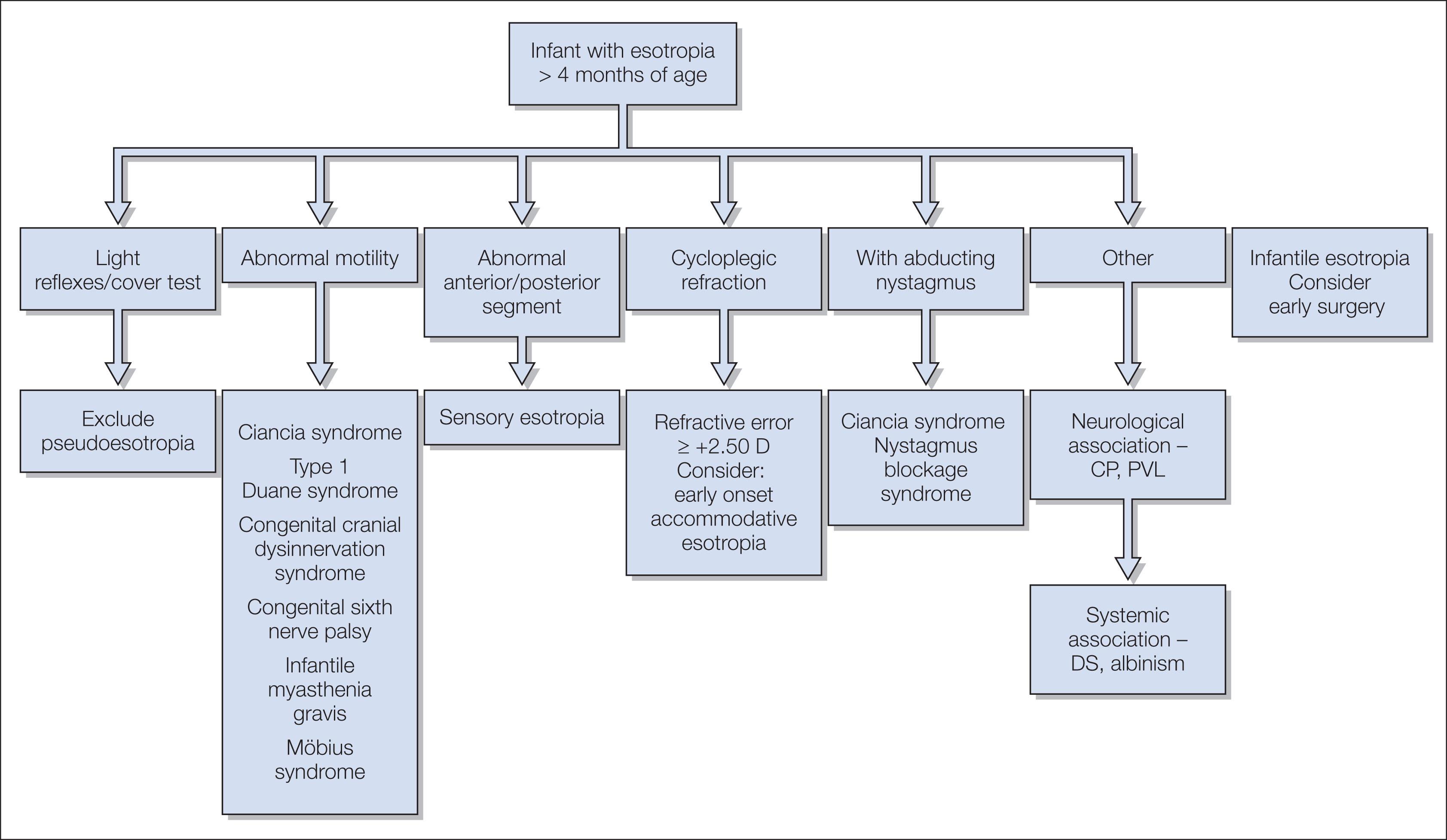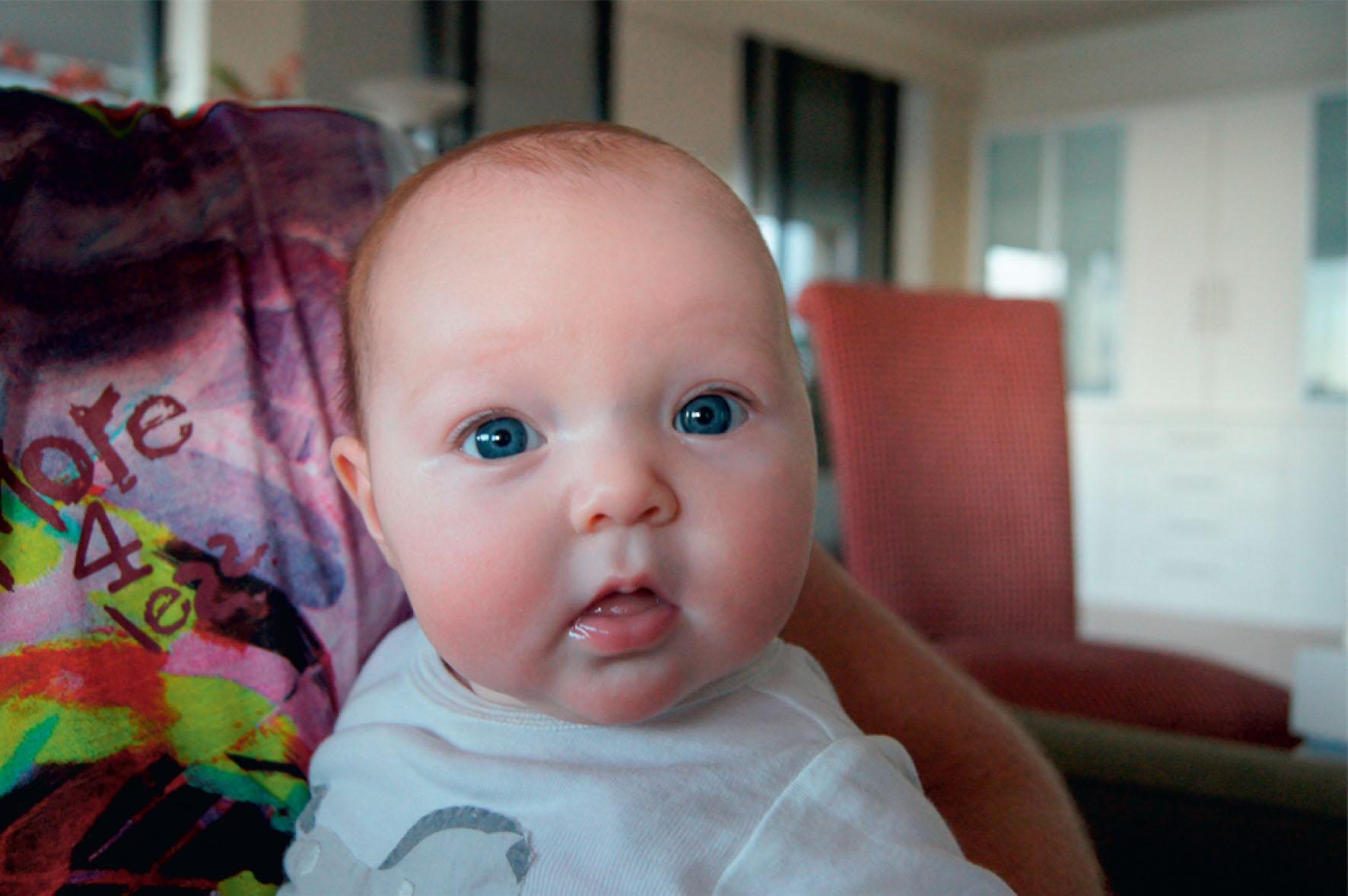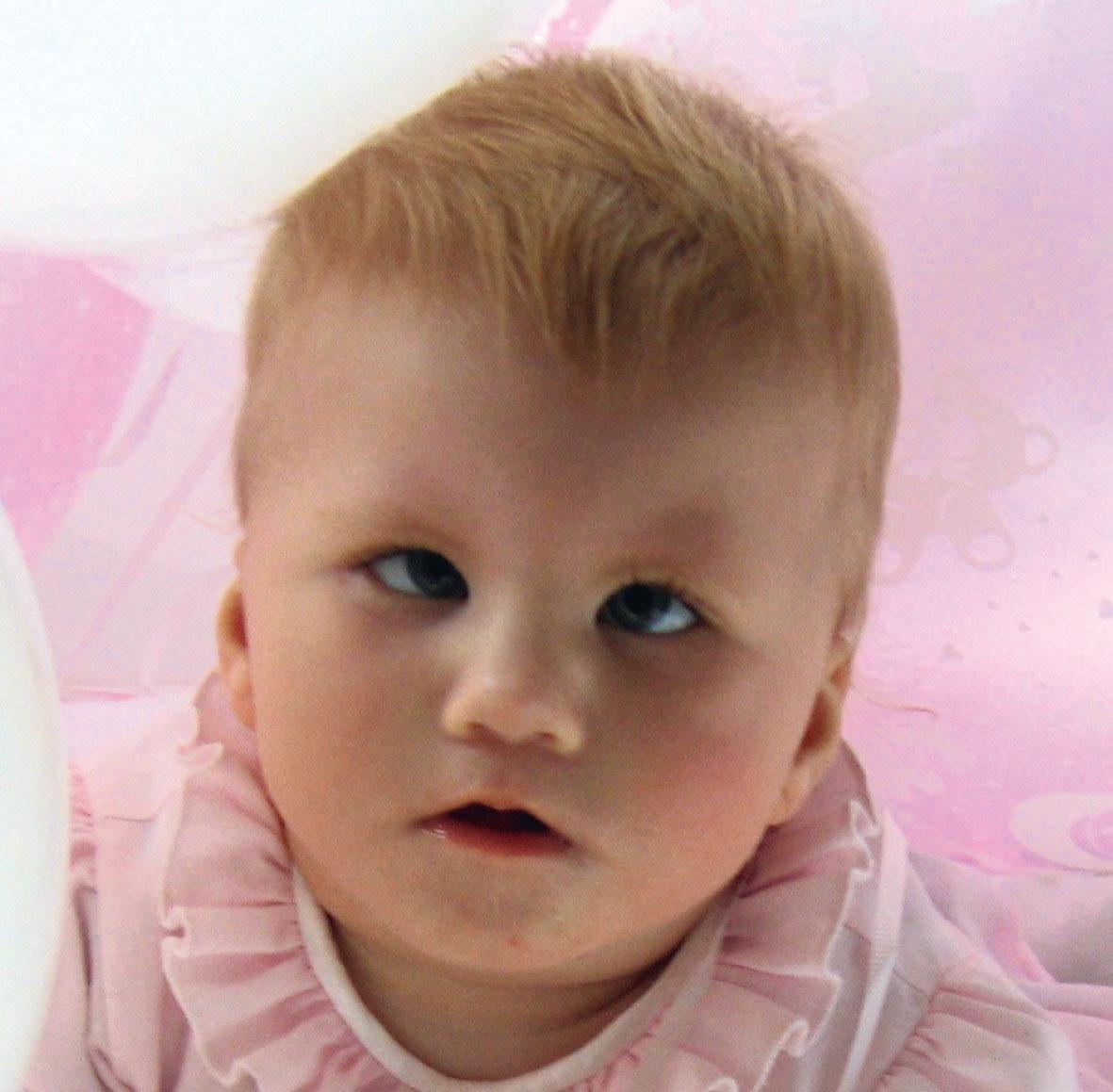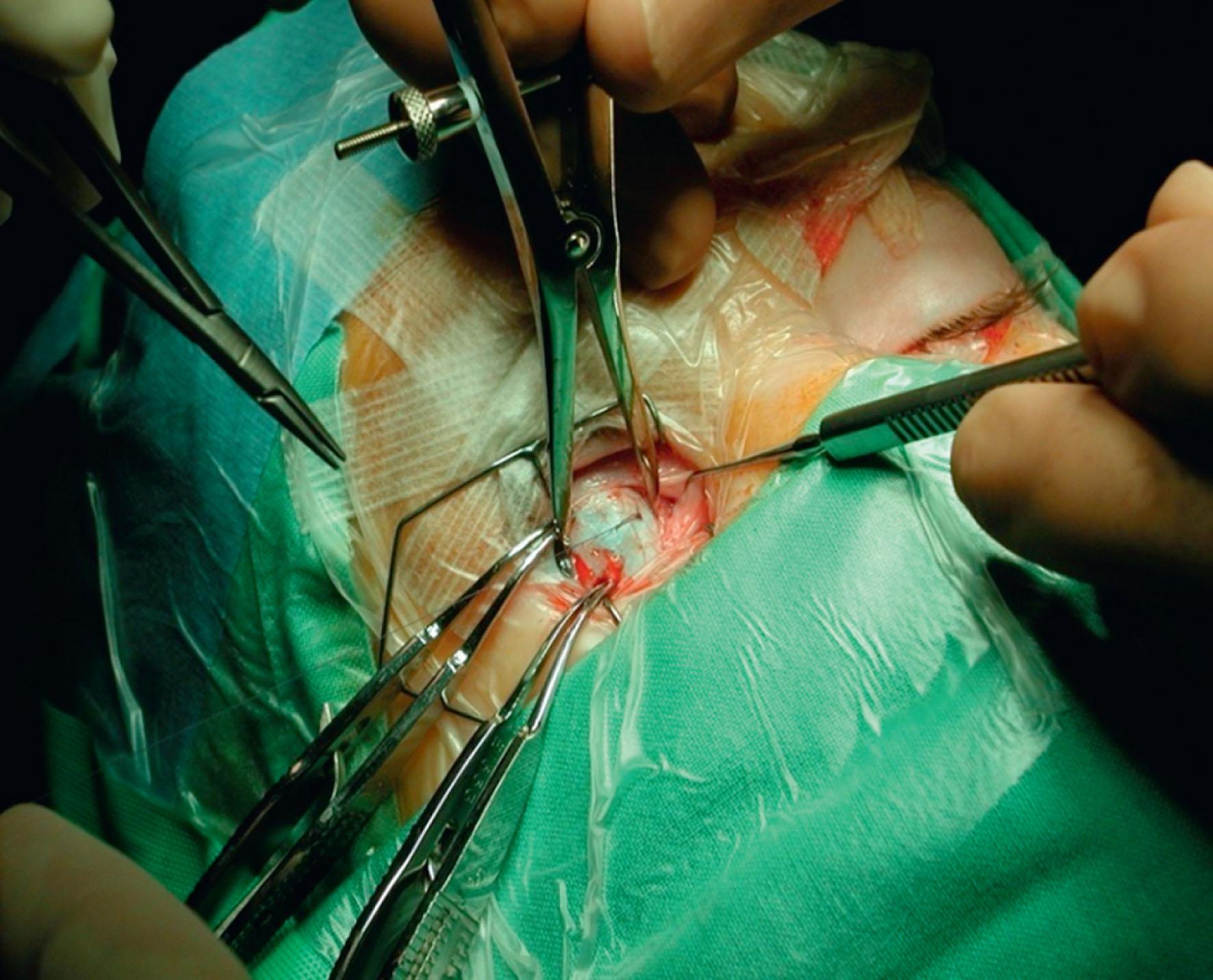Physical Address
304 North Cardinal St.
Dorchester Center, MA 02124
First, we must, I believe, firmly embed strabismus in the matrix where it belongs – an anomaly of neurodevelopment. John T Flynn
Infantile esotropia (IET) is defined as a constant non-accommodative esotropia with onset before 6 months of age in a neurologically normal child ( Fig. 77.1 ). The angle of strabismus is generally >30 prism diopters (PD), there is usually mild or no amblyopia and refractive error is low to mild hypermetropia. The term “infantile esotropia” reflects modern concepts of pathogenesis. “Congenital esotropia” is often used synonymously but this condition is almost never present from birth and there is accumulating evidence that these children have the potential for good or near normal binocularity if they are treated early, i.e. the underlying defect is not congenital or immutable. Animal studies support the idea that IET is caused by decorrelation of cortical inputs but subcortical centers may also play a role.
Infantile esotropia is often accompanied by secondary associations such as dissociated vertical deviation (DVD) 50%–90%, inferior oblique overaction (IOOA) 70%, latent nystagmus 40%, and optokinetic asymmetry. Infantile esotropia and the secondary associations are often grouped together under the term “infantile strabismus complex”; some components may exist in isolation even in the absence of strabismus.
The prevalence of any esotropia in a population of 38,000 children aged 1–2½ years was found to be 0.9% in 1980 while the prevalence of IET over a 30-year period in one area of the United States was found to be relatively constant at 0.25% of the population. The overall rate of strabismus surgery in childhood has shown a substantial decline in Western countries in recent decades, possibly due to prescribing the full cycloplegic refraction (with no “correction for ciliary tone”) in strabismic children. However, despite the apparent overall decrease in strabismus surgery, Carney et al. stated that the rate of surgery in children under 1 year was unchanged possibly because the treatment of IET is mostly surgical.
Infantile esotropia often runs in families indicating a hereditary component. Primary monofixation syndrome occurs much more commonly in the parents and families of children with IET than in the general population. Maumenee et al. concluded that the inheritance pattern was most likely Mendelian codominant.
The differential diagnosis of IET can be considered as either truly congenital or early onset (within first 6 months) ( Table 77.1 ). In most cases, a thorough history and ophthalmic examination helps to differentiate the subtypes ( Fig. 77.2 ).
| True congenital | Infantile onset |
|---|---|
|
|

Pseudoesotropia is very common in clinical practice, particularly if early referral has been encouraged. It can be confirmed by performing the Bruckner, Hirschberg, and cover tests to determine that the eyes are orthotropic ( Fig. 77.3 ). Note that the Bruckner test can have false positives in children younger than 8 months of age. If pseudostrabismus is suspected, we take a digital photo during the office visit and ask the parent to confirm that the image shows the appearance of concern to them. Often while the child is dilating, we ask parents to look through their smart phones and identify old photos where they think their child’s eyes are crossed. It is very helpful to look at the photos with the parents to demonstrate that their child appears esotropic due to asymmetry of nasal scleral show between the two eyes as a consequence of a broad nasal bridge/prominent epicanthal folds. Often, directing the parents’ attention to the child’s ears in the photographs will emphasize the fact the head is not straight since one ear is much more obvious than the other. Thus, the child is in side-gaze, and this explains the absence of scleral show in the adducted eye which is hidden by the epicanthic fold. Children initially diagnosed with pseudostrabismus were reported to show a 12% rate of strabismus or amblyopia when re-examined at 3 years of age. In a big data set of infants (N = 17,885, median age 1.65 years) with an initial diagnosis of pseudostrabismus, 9.6% subsequently developed strabismus, compared to 1.7% of controls.

In infants with esotropia caused by type 1 Duane syndrome, the diagnosis is confirmed by limitation of abduction and globe retraction in adduction. Mild type 1 Duane syndrome can be difficult to distinguish from IET, particularly if the child is cross fixating as the globe retraction in adduction can be quite subtle in infants. If the angle of misalignment is such that the child requires surgery, then bilateral medial rectus recession (BMRc) is the treatment for mild cases of IET or Duane syndrome anyway. Particular care must be taken to exclude Duane syndrome in infants with larger angles (60 PD) when three muscle surgery involving a lateral rectus resection is contemplated. Performing a doll’s-eye maneuver to demonstrate full abduction will exclude a congenital sixth nerve palsy, a generally benign condition which usually resolves by 6 weeks of age. Other useful techniques to elucidate abduction include rotating the child or using a period of monocular occlusion to unmask abduction in the non-occluded eye. The presence of a sixth and seventh nerve palsy together in a child with esotropia may be due to Möbius syndrome, which is usually associated with a number of other orofacial abnormalities ( Fig. 77.4 ).

A full ophthalmic examination including cycloplegic refraction will exclude any anterior or posterior segment cause for a sensory esotropia. Retinoblastoma must be excluded in any child who presents with strabismus. Congenital abnormalities of the optic nerve such as optic nerve hypoplasia, “morning glory” disc anomaly, and optic nerve coloboma are important causes of sensory esotropia in infancy; beware of their associated systemic disorders (e.g. optic nerve hypoplasia can be associated with hypopituitarism).
Nystagmus blockage syndrome (NBS) and Ciancia syndrome are now largely historical terms used in children with large angle infantile esotropia and share in common a generally large angle of deviation, bilateral limitation of abduction (often actually pseudoabducens paralysis), jerk nystagmus with the quick phase toward the side of the fixating eye, increasing with abduction and decreasing (sometimes disappearing) with adduction with a head turn in direction of the fixing eye. Although the features outlined in the original description of these conditions overlap, the underlying pathophysiology is thought to be different; in Ciancia syndrome, the esotropia and nystagmus appear, purely coincidental whereas in NBS the patient has congenital idiopathic nystagmus with the null point in adduction (causing esotropia). Accommodation/convergence innervation may play a role and pupillary constriction in adduction may assist in making the diagnosis of NBS.
These conditions appear to be part of a similar spectrum and should be considered in any esotropic child with abducting nystagmus. Ciancia syndrome has been considered the underlying diagnosis in up to one-third of infantile esotropes and has been given the synonym “cross-fixation congenital esotropia.” With such a high incidence there is probably some overlap with large angle infantile esotropia. Von Noorden reported prevalence of NBS between 4.8 and 10.3% of congenital esotropes so an overlap probably exists here as well. In patients with alternating esotropia and cross-fixation, there is no nystagmus with fixation in primary position or abduction, the fixating eye usually is in the primary position with the non-fixating eye adducted (unlike in NBS where both eyes are in adduction) and there is often no amblyopia (unlike in NBS where amblyopia is quite common. These features may assist in differentiating NBS from infantile esotropia. Despite the overlap in clinical features of Ciancia syndrome, NBS and large angle infantile esotropia, the treatment is the same, with large bilateral medial rectus recessions producing good motor outcomes in most cases. Three muscle surgery may be appropriate for larger angles of misalignment, of course.
The prevalence of strabismus in children with developmental delay is variably reported between 27% and 100% (compared to that of a healthy full-term child of around 1%). Rates of strabismus reported in developmentally delayed children are often based on combined cohorts of patients with multiple causes such as perinatal hypoxia, premature birth, and periventricular leukomalacia (PVL), cerebrovascular accident, hydrocephalus, meningitis, Down syndrome, cerebral palsy, and seizure disorders. Haugen et al.’s population-based longitudinal study found that strabismus occurred in 42% of patients with Down syndrome and was predominantly early onset esotropia (84%) and associated with hypermetropia. The rate of strabismus in patients with cerebral palsy is 44% on average (15%–62%). This high prevalence in children with various causes of developmental delay is not unexpected given the neurologic substrate of strabismus
DVD occurs in any ocular condition where there is disruption of early binocular development (e.g. early onset strabismus, monocular congenital cataract, corneal opacity) and was reported in one series of infantile esotropia to have a mean onset of 2.8 years. It is present when a non-fixating eye elevates and extorts and can occur spontaneously during patient fatigue (manifest) or may be observed when binocularity is dissociated, e.g. the fellow eye is occluded (latent). DVD does not follow Hering’s Law so it is not associated with a corresponding downwards movement of the other eye when fixation is resumed ( Fig. 77.5 ). Synonyms include alternating sursumduction, alternating hyperphoria and occlusion hyperphoria. In any one patient, DVD can vary both in size and frequency of occurrence. A recent study of DVD occurring in infantile esotropia demonstrated that, especially in children with larger preoperative angles, surgery before 24 months resulted in a lower incidence of manifest DVD. Rarely, the patient adopts a head tilt to the same side to control the deviation. For management purposes, DVDs can be graded as small, medium or large or the deviation can be roughly quantified with base-down prism such that the DVD is neutralized (prism under cover test). To neutralize, the prism is placed in front of the eye with DVD until the upward and downward movement are identical on alternate cover testing. Both DVD and IOOA are usually bilateral but can be asymmetrical. DVD occurs with or without associated IOOA. The two may be difficult to distinguish but the hypertropia of DVD is present in all directions of gaze unlike that of IOOA which is greatest in adduction ( Fig. 77.6A–B ). If the eye elevates in adduction and there is a corresponding (equal in size) hypodeviation in the opposite eye on alternate cover testing, the deviation is entirely due to IOOA. If there is no corresponding hypodeviation, then only a DVD is present. If the elevation of the adducted eye exceeds the hypodeviation in the fellow eye, then combined DVD and IOOA are present; the difference between the two vertical measurements is the extent of the DVD. IOOA is also associated with fundus excyclotorsion ( Fig. 77.6C ) and a V pattern esotropia. Inferior oblique overaction is graded on a scale of 0 (normal) to 4+ (massive overaction). Overaction of 2+ occurs when the eye elevates in adduction when the fellow eye is fully abducted horizontally.


Dissociated horizontal deviation (DHD) is defined as a change in horizontal ocular alignment, unrelated to accommodation, that is brought about solely by a change in the balance of visual input from the two eyes. DHD occurs much less frequently than DVD. It is often asymmetric and can occur simultaneously with DVD. Indeed, DHD may merely be a DVD with a large horizontal component. It can cause confusion with consecutive XT and the two may coexist. The two can be distinguished by a difference in horizontal measurements when measuring with the prism in front of each eye separately. The treatment is a supramaximal lateral rectus recession of the affected eye.
Fusion maldevelopment nystagmus (FMNS, previously known as latent nystagmus) is a common accompaniment of infantile esotropia and occurs on monocular occlusion. The fast phase is towards the uncovered eye. The nystagmus is lessened in adduction and worsened in abduction. Accurately measuring the visual acuity in the presence of latent nystagmus can be difficult because the nystagmus can dramatically lower the acuity in the uncovered eye. This can be resolved by fogging the eye not being tested with a +3.00 lens (to maintain binocular input) rather than occluding it. Alternatively, asking the patient to view the chart with the eye adducted may reduce the nystagmus amplitude. FMNS can become “manifest” when it is present in binocular viewing. Patients with a history of infantile esotropia who do not develop fusion are sometimes noted to have an anomalous head posture; this is likely related to the null-point of their FMNS. It still retains the unique property that the slow phase of the nystagmus is always towards the nose under monocular conditions.
Infants under 2 months of age show greater sensitivity to objects (such as the stripes on an optokinetic drum) moving from temporal to nasal in their visual field than objects moving from nasal to temporal. This asymmetry disappears by 4–6 months of age in normal infants. This nasalward bias in infants persists when infants develop IET and becomes permanent.
The vast majority of patients with IET will require surgical correction with the aim of leaving the patient with a misalignment of <10 PD of esotropia so that the patient will be a monofixator at the least. Orthotropia or microesotropia give better long-term results than microexotropia. Because of eye size, surgery for IET can be technically demanding in children under 2 years of age which may explain why some surgeons are reluctant to embrace early surgery. Various surgical approaches are in use including bilateral medial rectus recession (BMRc, measured from the insertion or the limbus), unilateral recess/resection, and for larger angles some authors have reported their success with a “selective” approach by adding unilateral or bilateral lateral rectus resection for a three or four horizontal muscle surgery. Given the difficulties with accurate measurement for very large angles, we no longer perform four horizontal muscle surgery due to an unacceptable rate of overcorrection. For moderate angles of strabismus, we use amounts of surgery based on those reported by Helveston ( Table 77.2 ). For larger angles of strabismus ≥60 PD, we have developed and validated a surgical table for three muscle squint repair ( Table 77.3 ).
| Preoperative deviation (PD) | BMRc (mm)Age <1 year | BMRc (mm)Age >1 year |
|---|---|---|
| 25 | 8.5 | 9.0 |
| 35 | 9.5 | 10.0 |
| 40 | 10.0 | 10.5 |
| 45–50 | 10.5 | 11.0 |
| 55 | 10.5 | 11.5 |
| Preoperative deviation (PD) | BMRc (mm)Age <1 year | BMRc (mm)Age >1 year | LLRs (mm) | |
|---|---|---|---|---|
| 60–65 | 10 | 10.5 | 4 | |
| 70 | 10 | 10.5 | 5 | |
| 75 | 10 | 10.5 | 6 | |
| 80 | 10.5 | 11 | 6 | |
| 85 | 10.5 | 11 | 8 |
We prefer to perform bilateral medial rectus recessions (BMRc) rather than a unilateral recess/resect procedure because it is technically easier, quicker, and does not involve a loss of muscle tissue. A controlled randomized comparison of BMRc and unilateral recession/resection procedures reported no difference in outcome. There was considerable debate in the 1980s about whether to measure the recession amount from the insertion or from the limbus. In children with IET, the position of the muscle insertion varies from 3 to 6 mm from the limbus and can also vary according to the degree of traction exerted during surgery. Some of this insertion variability, especially when caused by traction from surgical forceps, could be due to less scleral rigidity reflecting the incomplete collagen cross-linking in infant sclera. Kushner and Morton proposed that unreliable results may be minimized by measuring surgical recession from the limbus rather than the insertion. They reported success in 84% of cases of mean preoperative deviation of 53 PD after performing 10.5 mm BMRc from the limbus. This was significantly better than graded recession from the insertion. We also prefer measuring from the limbus because this is a constant ocular landmark ( Fig. 77.7 ). A table of numbers for recession amounts measured from the muscle insertion is listed elsewhere in this book ( Chapter 88 ).

Eye growth is rapid in the first few months of life, especially in the posterior segment producing major alterations in the insertion sites of the muscles relative to the equator so the determination of surgical dosage under the age of 6 months may be difficult. However, Helveston reported that this was not an issue when surgery was carried out at 4 months of age or later. Measuring medial rectus recessions from the limbus often appears to place the muscles at or behind the equator during surgery in an infant (the surgeon must trust the tables, which are based on decades of experience!). Kushner demonstrated that the medial recti could safely be recessed to 1.5 mm behind the equator before underaction of the medial rectus would occur. We suture directly to the sclera although some find hang-back sutures technically easier: the results are comparable.
Successful alignment with BMRc (measured from the insertion or the limbus) in children with IET (30–100 PD) has been variably reported to be between 30% and 90% with a wide range of duration of follow up. Many series report success rates of approximately 80% with one operation. The prevalence of larger angles >60 PD among children with IET is 18% and few studies have reported the results of surgery for this group in isolation. Undercorrection rates are still significant and have been proposed to be due to inadequate surgery amounts and/or the variability of the medial rectus insertion. Scott retrospectively compared BMRc 5–6.5 mm from insertion with three horizontal muscle surgery (BMRc measured from the limbus with lateral rectus resection) in angles >50 PD. Success to orthophoria was 37.3% for the two horizontal muscle repair group with residual esotropia in 58%. Success in the three muscle group was 64.5% using a graded BMRc from the limbus with lateral rectus resection depending on the preoperative deviation. Under- and overcorrections at the 6 week postoperative review were almost equal (20.8% residual esotropia; 16.6% exotropia >10 PD), however, longer term, the overcorrections did not persist at the final follow-up. The results of a recent series of cases of two muscle surgery (BMRc) for large angle IET were reported as poor (17% success), which improved to only 48% with botox augmentation at the time of muscle surgery. Because of generally poor success rates, we do not recommend either approach (two muscle squint repair ± botox) for large angle infantile esotropia; we prefer three horizontal muscle surgery. However, Weakley et al. reported good patient outcomes (75% short-term success) with bilateral 7.0 mm recessions of the medial recti, as did Damanakis for 8.0 mm recessions for 80–90 PD of esotropia. However, both papers had less than 2 years’ follow-up so the long-term outcomes are not known and very large angles of esotropia are impossible to measure accurately.
We conducted a validation study of a table guiding surgical dosage for three horizontal muscle surgery for 51 patients with larger angle infantile ET and reported successful alignment to within 10 PD of orthotropia in 91.3% at 1 year, 77.8% at 4 years, and 73.6% at 8 years using Kaplan Meier life table survival curves. Chatzistefanou et al. more recently published their retrospective analysis of 194 patients with large angle IET >50 PD from a single surgeon performing BMRc and unilateral LRs with similar results.
Surgery for esotropia in the developmentally delayed has shown variable postoperative alignment outcomes; some groups report high rates of overcorrections and unpredictable outcomes when using standard surgical tables. Whilst PVL is usually diagnosed prior to presentation to the ophthalmologist, Muen et al. reported suboptimal surgical results in seven patients who were unexpectedly diagnosed with PVL after presenting with strabismus. While some authors make a practice of decreasing the surgical dosage, Yahalom suggested that adjustment (reduction) of standard surgical dosages for esotropia in Down syndrome is unnecessary. In 2015, Park and Oh reported an excessive surgical dose response in premature infants compared to full-term patients and reduced their surgical dosage to reduce overcorrections.
When treating coexisting vertical misalignment, inferior oblique surgery can be incorporated at the time of initial surgery if the IOOA is significant (≥2+ to 4+), and especially if a significant V pattern (>20 PD) is present. The options for inferior oblique weakening include recession, anterior transposition, and myectomy. In a large series (N = 61) Mims et al. reported that bilateral anterior transpositions also reduced the need for DVD surgery when compared to patients who did not undergo anterior transposition. We do not perform inferior oblique myectomy at all in patients with IET because this prevents use of this muscle to treat DVD at some future time. If IOOA exists in isolation, we perform an IO recession, graded according to severity. If IOOA and DVD coexist, our preferred operation is graded IO anterior transposition to avoid operating on both elevators (IO and SR). If DVD is present alone without IOOA, we perform a large ipsilateral superior rectus recession. Surgery for DVD alone can be performed when the child is older as it is performed for predominantly cosmetic reasons. Surgery for DHD follows a similar principle to surgery for DVD, supramaximal recession of the ipsilateral lateral rectus.
Become a Clinical Tree membership for Full access and enjoy Unlimited articles
If you are a member. Log in here